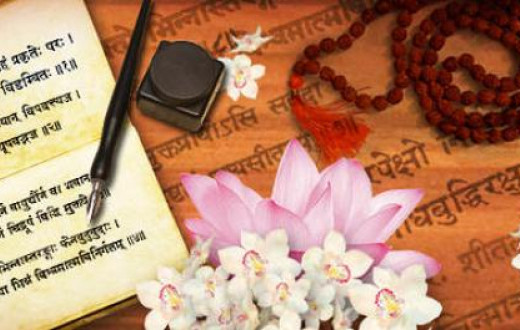
We shall begin this Janmashtami’s celebration with silence, and let the festivities end in a celebrative and joyful silence.
There are four main dimensions through which we should see our life.
The first is Saamipya. It means to feel that those who are very dear to us are also very close to us and are always with us - whether it is your Guru, God or even a Jnani (wise or knowledgeable person). So you must know that Lord Krishna belongs to you and is with you at all times. Just take this for granted.
When you say that 'Gurudev belongs to everyone', then you tend to feel a bit distant from the Guru. But when you say that 'Gurudev belongs to me', then you experience that nearness and closeness with the Guru.
Experiencing this intimate bond with the Guru does not depend on place and time. No matter where you are, you can experience this nearness. Just take it for granted that you are very dear and close to the Guru. It is just like how you treat someone who is closely related to you.
If you think that you are distant from the Guru, or the Knowledge, or God Himself, then that is what will start to happen also. Just know for certain that you are very dear and very close to the Guru. When you stay firmly established in this thought despite all obstacles and doubts, then you acquire Saamipya-siddhi (the experience of being very close to the Guru). Then you will feel that you are always close to the Guru, and the Guru to you.
Just take it for granted that you are very dear and close to the Guru. It is just like how you treat someone who is closely related to you.
If you think that you are distant from the Guru, or the Knowledge, or God Himself, then that is what will start to happen also.
When this happens, then the next thing you experience is Saanidhya – which means to truly feel the presence of the Guru, or God. So first you should believe totally that you are always close to the Guru, despite all odds that may shake this faith. This is Saamipya. Then in no time you will be able to feel their presence near you, as if they are standing right beside you or behind you, and are deep within your very being. Such is the deep feeling that arises in one’s heart.
How many of you here have experienced this? (Many in the audience raise their hands). This is the sign of a sincere seeker.
This experience too does not depend on the place or time one is in. It is not that only if you come to the Ashram you will be able to experience the Guru’s presence. No, it is nothing of that sort. You can have this experience anywhere and at any time. The moment your mind becomes quiet and you reposes in your Self, that very moment you can feel the presence of the Guru.
There are many Art of Living teachers sitting here. How many of you feel the presence of the Guru when you sit to teach the Happiness course? (Many teachers in the audience raise their hands). You surely experience it, which is why you are able to teach the course. Many times you give answers to the participants which you yourself did not know. When you sit to take the course and someone asks you a question, the right answer just comes from within at that very moment. This is Saanidhya.
The third is Saarupya. It means to feel that the Divine is present in every particle of our being, and we have the same look and form as the Divine.
During festivals like Janmashtami and Ram Navami, it is a tradition in India to dress young children in the attire of Lord Krishna or Lord Rama. This feeling is to see the form of the Divine in each and everything around us. In some religions and traditions in the West, this is considered to be a crime or a serious insult to the Divine. Dressing up like their Gods or their prophets is considered to be a crime in those cultures. But we in India do not think like that. Instead, we see it as a way of deeply adoring and honouring the Divine. That is why during these festivals you will see that in every other street, one child is dressed as Lord Rama; another gets dressed like Devi Sita, and some other child tries to look like Lord Hanuman.
We do everything we can to look like these deities and imitate them in the best way possible. The thought behind this is that if you must imitate someone, then why not imitate the Divine, and why not look like God Himself.
But while doing this, you should not cheat people. Do this for your own joy, but not for others. So do this with pure and clear intentions for your own happiness, and not to cheat or trick others for something.
When someone is worshipping the Mother Divine with intense devotion and love, then you will feel as if it is the Mother Divine Herself is present there, and not the person. Just like how someone starts imbibing all the qualities of Lord Krishna as they go deeper and deeper into worshipping and adoring Him. This is what happened to Devi Radha and Saint Mirabai also. It is what happens to all devotees. When they are soaked totally in the love for the beloved, the Divine, then they see no difference between them and the Divine. No matter where they look, they see nothing but the Divine. Every form and being appears to be no other than the Divine. This is Saarupya.
When you are soaked totally in the love for the Divine, then you see no difference between yourself and the Divine. No matter where you look, you see nothing but the Divine. Every form and being appears to be none other than the Divine.
Then the final step is Saayujya (to merge and be one with the Divine). In Saarupya also, there is intense longing for the Divine. The devotee is in love with the form and appearance of the Divine. There is intense devotion, but there is also longing and restlessness to unite with the Divine.
Saint Mirabai has said that 'If only one knows how painful is the longing that comes with Divine love, then I would roam the streets telling people not to fall in love! '
Such is the pain of longing that comes with the intense devotion for the Divine. It is at this stage that one needs a Guru who can dissolve the difference between the devotee and the Divine. So when Mirabai finally met her Guru who gave her this knowledge, she was overwhelmed with joy and sang, 'Paayo ji maine Ram ratan dhan paayo' (O what bliss! I have found the mantra of Lord Rama, the most precious of all gems! ). Just see how wise and established is the Guru. He knew that Mirabai is in love with Lord Krishna and could not bear the intense and painful longing for Him that came with her devotion, so her Guru told her a very different thing altogether. He could see that she was overwhelmed with both devotion and the intense restlessness of separation from her Lord and so he gave her a mantra dedicated to Lord Rama instead.
Lord Rama and Lord Krishna are as different from each other as the earth and the sky. Whatever Lord Rama did in His lifetime, Lord Krishna did the exact opposite of it all. Lord Rama was born at 12 in the afternoon, while Lord Krishna was born at the stroke of midnight. There was so much festivity and celebration at the eve of Lord Rama’s birth. But there was widespread fear at the time of Lord Krishna’s birth. Lord Rama was born in the royal palace, Lord Krishna was born in the royal prison. There were celebrations everywhere when Lord Rama was born. But when Lord Krishna was born, his father feared for His life and secretly took Him to Gokul in the dark night (to save the infant Krishna from being taken away by the evil Kamsa).
There is so much contrast and difference in their personalities. Lord Rama always remained as a disciple, He was never a Guru to anybody. Lord Krishna on the other hand was always a Guru to everyone around Him from the very beginning. At first Lord Krishna revealed His true divine form to Mother Yashoda and gave her the knowledge of who He really was. Then He became a Guru to His father also. When He went to Guru Sandipani for education, He became a Guru to him too, though he stayed as a student in his Gurukul during that time to fulfil his role.
It is said, 'Guru bina gati nahi' (Meaning: One cannot progress and evolve without a Guru). So to fulfil this saying from the scriptures, Lord Krishna went and lived as a disciple with Guru Sandipani, though He Himself was a Guru. His Guru was so elated to have Him as his disciple that he said, 'O Lord, I am so fortunate to get the chance to give knowledge to You, when you yourself are the Guru of the entire world. You are so kind to have given me a chance to be Your Guru and serve you'. Guru Sandipani never said these words but these were the intense feelings that arose in his heart for Lord Krishna.
A Guru alone knows how to bring balance to the life of the devotee.
It is said, 'Guru bina gati nahi' (Meaning: One cannot progress and evolve without a Guru).
Lord Rama was devoted to one wife only, and adhered to Dharma and the scriptures at all times regardless of what happened. Lord Rama would consider His father’s instructions as absolute and would never disobey. Lord Krishna on the other hand was naughty and never once listened to His father (laughter). If His father said go left, Lord Krishna would turn right. If His father asked Him to not go to Mathura, Lord Krishna would insist 'No father, I must go to Mathura'.
Mirabai’s Guru gave her the mantra for Lord Rama. Why? It is because a Guru alone knows how to bring balance to the life of the devotee.
She was so overwhelmed and carried away in her intense devotion that she could not find peace because of the longing that came with it. But her Guru knew what was needed, so he gave her the mantra and helped make her steady and established in devotion to the Divine. This is why Mirabai, a devotee of Lord Krishna sang the praise of Lord Rama, 'Paayo ji maine Ram ratan dhan paayo; Vastu anmol diyye mere Sadguru' (O what bliss! I have found the mantra of Lord Rama, the most precious of all gems! So priceless is the gift my Sadguru has bestowed upon me) .
That is when she found Saayujya. It means to dissolve in the Divine, to unite and become one with the Divine totally. This is the ultimate state of devotion. To meditate and be in a state of Samadhi (feeling of merging with the non-dual one Consciousness) – this is a sign of being in Saayujya.
You must contemplate upon the knowledge heard again and again and imbibe it deep within yourself.
You know, there is a special meaning to the Annakuut festival also. It is to celebrate this deep feeling of abundance, and to acknowledge the grace and prosperity in life. It means there is no lack of any kind. It is to celebrate the fullness in life.
We should consider ourselves to be very fortunate. The Creator of the entire world is with us, what lack can one possibly have then! The Divine is there to remove and do away with any lack or shortcoming one may have.
See, the feeling of lack is always in the mind first. That is why we celebrate Annakuut during Janmashtami to celebrate abundance and remove any feeling of lack we may have. The purpose of Annakuut is to unite everyone and bring them all together in harmony, regardless of caste, creed, religion and any other differences. People come together, sing, dance and just celebrate this feeling – Annam Brahma (Food is the Divine). So during Annakuut, you honour the grace and bounty of the Divine through food.
In our culture, we have connected every aspect of our life with the worship of the Divine. We remember the Divine even through our food, and we also honour the knowledge that is associated with it. This is a very unique and beautiful principle, and an honourable tradition in our culture.
(Note: The discourse was given in Hindi. Above is a translation of the original talk.)





































